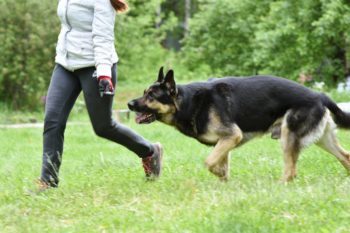Pet Training and Obedience. You love your pet, but sometimes it can be hard to know what you should do when they misbehave.
What’s more, no matter how well-intentioned you are, some people might not appreciate your methods and criticize you for being too harsh or even abusive. It’s important that we all remember one thing: while pets may look like small children in our eyes, they are still animals with a different upbringing and a different way of being trained. Here are some tips on how to avoid problems when training your pet:

• Use positive reinforcement as much as possible. Punishment will only ever cause more problems later down the line, so focus on rewarding good behavior rather than considering negative consequences.
• Be patient. As with kids, you can’t expect a pet to instantly behave or understand what they’re supposed to do.
• For some pets it’s more important to let them run free and exercise outside than training them all day long. Some animals need a specific kind of exercise that only comes from letting them roam in the wild or going for walks.
• Whenever you introduce a new element to your pet’s life, be patient. It might take them a couple of days before they’re ready to accept it as part of their day-to-day life.
• There are also times when specific animals need extra care and attention – check with a vet or someone who knows about that kind of animal before beginning a training plan.
• Make sure your pet isn’t being mistreated – they can’t tell you if something is wrong, so keep an eye out for signs that things aren’t going as they should be.
• When teaching a dog not to bark or how to behave in a certain situation, always remember that the goal is to keep them safe and sound, not to make life difficult for them or be unfair.
Remember that no matter how much you love your pet, they are still animals who need time to adapt to any situation. Keep this in mind whenever introducing something new to their environment – whether it’s a piece of furniture or a new person who joins the household. Rely on positive reinforcement and patience, and you’ll be able to train your pets with ease – no matter what tricks they’re supposed to learn!
Positive reinforcement: A technique used in animal training that reinforces desired behaviors by using treats or other rewards.
Patience: The ability to be calm and not get upset when faced with difficulties.
The goal is to keep them safe and sound, not to make life difficult for them or be unfair: If you are in charge of another living being it’s important to remember that you’re responsible for their safety, happiness, wellbeing, etc.
No matter how much you love your pet, they are still animals who need time to adapt to any situation: Pets have a different upbringing and a different way of being trained. While pets may look like small children in our eyes, they are still animals with a different upbringing and a different way of being trained.
It’s important that we all remember one thing: While pets may look like small children in our eyes, they are still animals with a different upbringing and a different way of being trained.
Use positive reinforcement as much as possible: This is used to reinforce desired behaviors by using treats or other rewards.
There are also times when specific animals need extra care and attention – check with a vet or someone who knows about that kind of animal before beginning a training plan: If you are incharge of another living being it’s important to remember that you’re responsible for their safety, happiness, wellbeing etc.
When teaching a dog not to bark or how to behave in a certain situation, always remember that the goal is to keep them safe and sound, not to make life difficult for them or be unfair: Remember that no matter how much you love your pet, they are still animals who need time to adapt to any situation.
What do we mean when we talk about training dogs? “
When we talk about training dogs, we usually mean teaching them to do behaviors on command or when they see certain objects or people they should go to. Training is also used to teach them general manners or housebreaking.
Training is usually done with a reward system – the dog learns that doing what you want will lead to getting rewarded, which causes it to be more likely to do what you want next time. There are many different ways of training, including using treats, clickers, and other things to get your pup’s attention. The type of training that works best depends on your specific dog – some need lots of praise while others need very little verbal interaction.
The most common types of training are:
-Housebreaking (this can take several months)
-Sit
-Stay
-Come when called
-Drop it/Leave it (not to be confused with Leave it, where the dog is told not to touch an object at all)
-Off (telling the dog to get off of something, whether it’s furniture or another dog)
-Get it (telling the dog to go get an object in another room)
Daily Routine
Housebreaking is done with a lot of patience and consistency – you must take your pup outside right when they wake up from sleeping, just before they eat or drink anything, immediately after they eat or drink anything, and right after they finish playing. It doesn’t matter what your pup is doing – only when it does it.
-Once you take your pup outside, make sure you wait a few minutes before taking them back inside for 30 minutes.
-After the first 2 weeks, your pup should start to “ask” to go outside, which you should reward them for.
-Praise your pup a lot when they go outside to reinforce that going outside was a good thing to do, and be careful not to punish them too harshly if they have an accident in the house – this will just lead to confusion on their part.
-When you take your pup back inside, take them straight to their crate and close the door – don’t talk to them for a little bit so they know being crated is not punishment.
-When you let your pup out of their crate, don’t spend too much time playing with them as this will just tell them that the crate means playtime – instead, give them a few minutes to run around outside and then let them back in their crate for a little while.
-Limit the amount of time your pup is out of their crate, even when you are playing with them so they don’t have accidents in the house.
Sit – When you tell your pup “sit,” they should go into a sitting position, with their bottom on the ground and their rump up in the air. Their back should be mostly straight, but their chest can be relaxed.
-Use a treat to lure your pup into the sitting position – hold it at the top of their nose while you slowly bring them downward. When they sit, praise them and give them the treat immediately.
-Play this game a few times and then stop giving your pup the treat – they should stay in the sitting position on their own now.
-When your pup gets used to that command, say “sit” and give them the treat only after they sit (you can step away after you say it).
Pet obedience
Pet obedience is important to ensure that your pet can be an enjoyable member of your family. Please note I’m not talking about dog training. There are emotional lives to consider, and emotional lives are different than emotional intelligence. Human beings have emotional lives just like animals do. Family members want their emotional lives to be happy and healthy. Pet owners want their emotional lives to be happy and healthy too. The language of emotional intelligence is different than the language of emotional lives. When you use emotional intelligence, your life will be happier and healthier without having to become more intelligent (whatever that means).
But if you use emotional lives, your emotional living will be happier and healthier no matter what kind of emotional intelligence you have. Let’s look at an example: Let’s say a dog is barking in its kennel and it can’t stop. It’s really annoying for everyone else in the house (emotional lives), especially since they just got home from work or school (emotional needs) and they need quiet time to feel good again before heading back to responsibilities and emotional needs again (relationships).
Using emotional lives instead:
The emotional living of people in the house is just as important as the emotional living of a dog in a kennel. This means you also want your emotional living to be happy and healthy, just like everyone else. That means when someone tells their pet to stop barking right away because they’re overwhelmed with happiness or emotional needs, that’s just as important as the emotional living of the dog.
Most people don’t understand emotional lives because emotional intelligence doesn’t help you understand emotional living – it just helps you change your emotional life so you’re happier and healthier (and other people are happier and healthier too).
This is one reason emotional intelligence fails to help emotional lives. Another reason emotional intelligence fails to help emotional lives is emotional needs. When someone says “barking” they might think about an annoying sound their pet makes when they want attention or food. But this isn’t what barking means either – barking isn’t a noise; barking is behavior. If the dog in the kennel were actually trying to get attention or food then it would emotional living of someone in a kennel.
Your emotional lives are as important as anyone else’s emotional lives – and emotional needs, and emotional intelligence too.
When you stop barking like a dog (whatever that means), it will make the emotional living of people in your house happier and healthier because their emotional needs can finally be met without having to worry about yours.
Emergency management with your pet
One of the most important things to consider is how to handle your pets in an emergency. This can be as simple as preparing a plan for what you’ll do if there is a hurricane warning and the family needs to evacuate or as complicated as preparing for situations such as a bomb scare, fire, or chemical spill that might disrupt your pet’s life.
The first thing we recommend is creating a plan, whether for minor emergencies or more serious ones. Don’t forget about the smaller details: what you will do if pets are allowed inside shelters and where to park your car so it’s safe from chemicals during a chemical spill.
A little bit of planning now will go a long way towards keeping you and your pets safe in an emergency situation.
The basics of pet training
It’s not easy to train your pet, but it is possible if you’re persistent and patient. One of the most important things to keep in mind when trying to train your pet is that it has intellect and can understand what you want it to do. As long as you are able to explain yourself clearly, there’s really no way for your dog or cat not to follow through on what you say.
We’ve found that the best way to get started with teaching your pet good behavior is by rewarding good behavior with food or praise. You’ll also need patience; don’t expect results overnight! Dogs especially take time before they will do what you ask them to do without questioning.
The best way to get your pets to listen is to reward them with praise or food when they do something you like. You’ll also want to be patient; it takes time for dogs in particular.
Dog owners and training
I’m not quite sure how you want to spend the rest of your life with your pet.
You could be like me and take a catastrophizing approach: “What if this one day my pet starts acting out and I can’t control him anymore?”
Or, you could take a more optimistic or hopeful approach: “How can I make sure my dog is always happy and healthy?” It’s up to you how you decide to spend your time with your pet. The love that you have for your pet is worth protecting.
Pets and emotional needs
Many people don’t think about their pets’ emotional lives or needs, but they are an important part of understanding what makes them happy. If you pay attention to how your dog responds to different things, you can figure out which types of activities make it more likely to be happy; this might help you understand why your dog is barking (for example).
Any type of relationship between a pet owner and their pet will benefit both parties as long as the emotional needs of the two are fulfilled. Both involved parties need to show interest in one another’s emotional lives if they want any kind of bond with each other.

